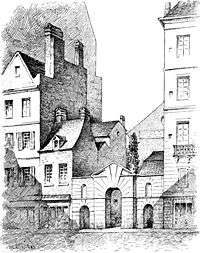Fraternal Society of Patriots of Both Sexes

The Fraternal Society of Patriots of Both Sexes, Defenders of the Constitution (French: La Société Fraternelle des Patriotes de l'un et l'autre sexe, Défenseurs de la Constitution) was a French revolutionary organization notable in the history of feminism as an early example of active participation of women in politics.
History
The Fraternal Society was founded in October 1790 by Claude Dansard, un maître de pension, or school master.[1] This organization's goal was to provide a civic education that would lead to revolutionary acts becoming a daily occurrence. An original characteristic of this group was the fact that they were widely inclusive to women.[2][3] Originally, the organization's meeting place was an old library room of the disused Dominican (called "Jacobins" in France) convent on Rue Saint-Honoré, the one which hosted the revolutionary Jacobin Club.[2][4] It has been suggested that the Fraternal Society grew out of the regular occupants of a special gallery allocated to women at the Jacobin Club.[4]
Within this organization there were two secretary posts that were guaranteed to women at all times.[2] The other positions would be divided up among the men and women members, making it much more egalitarian than previous revolutionary organizations. However the role of President was always held by a man.[2] The women and men sat among each other and each member referred to one another as "brother" and "sister".[5] The women possessed the same membership cards as men and were permitted to vote on matters.[2]
The members of this organization, of which Pépin Degrouhette,[1] Tallien and Merlin de Thionville were at one point presidents, debated the subject of liberty, France, and the Constitution with a zeal that was seen as surpassing that of the Jacobins.
The Fraternal Society lent the energy of their female members to long dull speeches of the Jacobins, which were enthusiastically cheered by vivacious female participants. who frequently rallied and energized their fellow revolutionaries.[2] There was also a strong bond between this revolutionary club and the others who shared the same democratic views, such as the Cordeliers, with whom they would sometimes organize rallies.[6]
Famous members
- Etta Palm d'Aelders[2][7]
- Louise-Félicité de Kéralio[2][8]
- Pauline Léon[2][7]
- Jacques-René Hébert
- Anne-Josèphe Théroigne de Méricourt[7]
- François Robert[1]
- Jean-Lambert Tallien
- Antoine Merlin de Thionville
See also
Notes
- 1 2 3 Aulard and Miall 1910, p. 234
- 1 2 3 4 5 6 7 8 9 Godineau 1998, p. 105
- ↑ Janet K. Boles, Diane Long Hoeveler, Historical Dictionary of Feminism, 2004, ISBN 0810849461, pp.301–302
- 1 2 John Goldworth Alger, Glimpses of the French Revolution: Myths, Ideals, and Realities, Sampson Low, Marston & Company, 1894 (Googe e-book), p. 144
- ↑ Aulard and Miall 1910, p. 236
- ↑ Godineau 1998, p. 106
- 1 2 3 McMillan 2000, p. 20
- ↑ Hazan 2012, p. 90 (footnote)
References
- Andress, David. "The Saint-Cloud Affair." Massacre at the Champ De Mars: Popular Dissent and Political Culture in the French Revolution. Suffolk, UK: Royal Historical Society, 2000. 118-19. Print.
- Aulard, F. -A., and Bernard Miall. "Formation of the Democratic Party." The French Revolution; a Political History, 1789–1804,. Vol. 1. New York: C. Scribner's Sons, 1910. 234. Print
- Godineau, Dominique. The Women of Paris and Their French Revolution. Berkeley: University of California, 1998. Google Books. Web. 7 Nov 2013.
- Hazan, Eric. "Chapitre IV La Constituante à Paris – Les Journées Des 5 Et 6 Octobre, Les Clubs, La Réorganisation Administrative, La Fête De La Fédération (octobre 1789juillet 1790)." Une Histoire De La Révolution Française. N.p.: La Fabrique, 2012. N. pag. Print. (In French)
- McMillan, James. "The Rights of Man and the Rights of Women, the Public Sphere Redefined." France and Women, 1789–1914: Gender, Society and Politics. London and New York: Routledge, 2000. 20. Print.